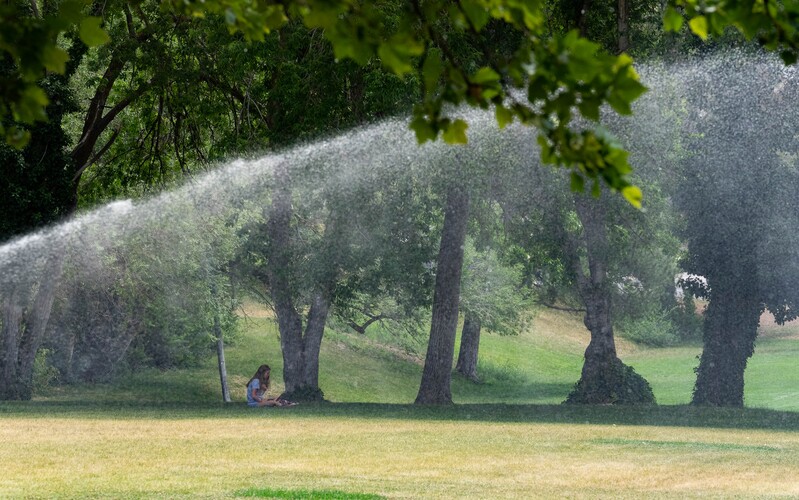While the weather is warmer and the slacklines were rolled out across Salt Lake City’s parks last weekend, it’s not quite time to hear the “ch-ch-ch” of sprinklers whirring.
With rain forecast later this week, Stephanie Duer, the water conservation manager for the Salt Lake City Department of Public Utilities (which also covers Cottonwood Heights, Mill Creek, and Holladay) said many lawns on the Wasatch Front can likely wait a little longer.
“I don’t anticipate watering my backyard lawn for another week or two,” Duer said, “and we might have rain Thursday and Friday so I would wait until after that.”
Duer doesn’t like to give a definitive date for when to start watering your lawn, but if current temperatures hold, it seems like early May will likely be a good time to start.

(Francisco Kjolseth | The Salt Lake Tribune) Sprinklers run at Reservoir Park in the middle of the afternoon heat during peak evaporations times on Monday afternoon, July 19, 2021, near the University of Utah campus.
The Utah Division of Water Resources publishes a lawn watering guide with customized advice for each county. Most of Utah, except for Grand, Kane, San Juan and Washington counties, currently don’t need irrigation. The guide is updated weekly.
Duer said watering guidelines may differ slightly for those with lawns on a slope that faces West or South and have very loose soil. Most lawns west of the Missouri River have clumpy, sticky, clay soil that can wait longer.
There are a few ways you can check whether or not your lawn needs to be watered.
If, after walking on your lawn, the blades remain bent over, it could be dry. Or, if your grass takes on a silvery hue it could be in need of some moisture. Duer also recommends grabbing a small screwdriver and gently plunging it into the soil. If you can’t get the screwdriver more than an inch into the soil, it’s time to water.
And when its time to turn those sprinklers on, Duer said there are many resources and approaches for those looking to lower their water usage.
Having a reasonable lawn footprint, choosing grasses that require less water, and purchasing sprinklers that efficiently spray water can all help Utahns enjoy green spaces and conserve at the same time. Utah State University offers a water check program that helps lawn caregivers create customized sprinkler schedules and identify water waste.
“Lawn isn’t bad,” Duer said. Green space and trees can help curb urban heat island effect. But Utahns can avoid overwatering or wasting water.
Simple changes to the way people water are already making a difference — in 2000 the peak demand (the day when people and institutions use the most water) for the Salt Lake Public Utilities services area was 210 million gallons of water. The peak demand now is between 165 to 175 million gallons.
Grass, even the popular but water-intensive Kentucky Blue variety, is fairly resilient. “Wait a day to water,” Duer said, “and you might find that you don’t have to water nearly as often as you think.”










